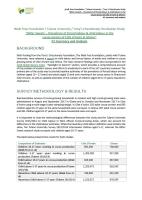The Walk Free Foundation, an Australian organisation dedicated to ending contemporary slavery and human trafficking, issued the 2018 version of their “Global Slavery Index” on 19 July 2018. The index provides a country by country ranking of the number of people in modern slavery, as well as an analysis of the actions governments are taking to respond, and the factors that make people vulnerable. This year, the Global Slavery Index featured a chapter on forced labour related to cocoa in Ghana and Côte d’Ivoire.
In partnership with Tulane University and with funding from the Dutch chocolate company and ICI-member Tony’s Chocolonely and the Chocolonely Foundation, this study aims at estimating the prevalence of forced labour of both adults and children, as well as child labour, in cocoa agriculture in Ghana and Côte d’Ivoire.
According to the findings, there is an estimated 1.5 million children – aged 10 to 17 – in child labour in Côte d’Ivoire and Ghana. In Ghana, there were 668,000 children were in child labour (including 632,000 performing hazardous tasks) out of the 708,000 children working in cocoa between August 2016 and August 2017. In Côte d’Ivoire, the number of child labourers between October 2016 and November 2017 was found to be 829,000 (including 769,000 working in hazardous conditions) out of the 891.000 working in cocoa production.
Less than one per cent of working children are forced to work by someone other than a parent, within the extended family. This corresponds to an estimated number of 2,000 forced child labourers in Côte d’Ivoire (0.17%) and 14,000 forced child labourers in Ghana (1.98%). The study came across very limited evidence of children forced to work by someone outside of the extended family (0.15% of children working in cocoa or around 1,000 victims of forced child labour outside the family).
These findings are consistent with previous research on the issue of forced child labour in cocoa, which reported that 0.4% to 0.9% of the current 2.1 million child labourers could be victims, or at-risk, of forced child labour.
The findings also shed light on the problem of forced adult labour in the cocoa sector, where the researchers found that an estimated 13 300 adults (3,700 in Ghana and 9 600 in Côte d’Ivoire), or 0.39% of adult workers in both countries, were subject to forced labour between 2013 and 2017. Adding in the potential cases of forced child labour, this estimate of nearly 30,000 children and adults in forced labour in cocoa production over the same 5 year period, is a sobering reminder of an extremely complex problem that merits close attention, and urgent, decisive action by all parties.
The report acknowledges the efforts of businesses and governments to address the exploitation of children in cocoa in cocoa such as the Child Labour Monitoring and Remediation System. However, the Walk Free Foundation stresses the limited focus on forced child and adult labour in cocoa and the relatively small amount of data that has been collected to date.
The report’s findings reveal that, whilst a localised and limited subset of broader risks to children and workers, the risk of forced labour is present in both countries. The study provides us with important knowledge, which can be used to adapt operational and policy interventions to better address forced labour in cocoa production.

